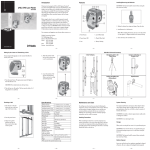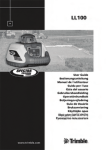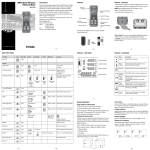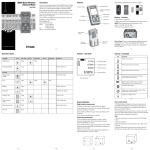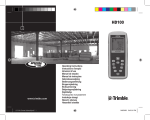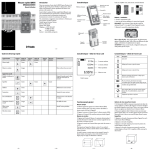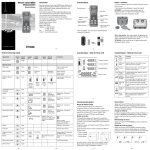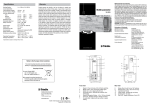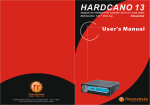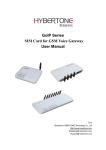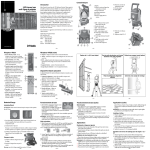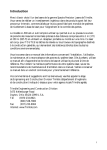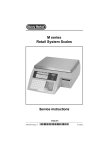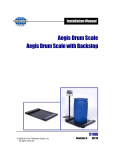Download LL500 User Guide
Transcript
Features and Functions LL500 Laser Level User Guide • 01. Power Button—turns the laser 2 on/off. 02. Handle—allows you to carry 3 the laser easily. 03. Battery Housing—holds four 1 4 D-cell alkaline or Ni-Cd 11 5 batteries. 10 6 04. Battery-Recharging Jack—is 7 the port that an optional battery 8 recharger plugs into. 9 05. Low-Battery LED—flashes when the batteries need replacing or recharging. 06. Rotating Prism—spins at 600 rpm to transmit the laser signal. 07. Bull’s-Eye Level—provides an easy reference for leveling the laser. 08. Leveling Screws—turn clockwise/counterclockwise so the laser can be leveled. 09. Leveling Base—supports the laser while it’s on the tripod. The leveling base also allows you to use the laser freestanding. 10. Lighthouse—is a 360° exit window for the laser beam. The lighthouse is sealed and protects the internal components from the environment. 11. Out-of-Level LED—flashes when the laser is out of its self-leveling range. 12. X Axis Calibration Screw— allows the X axis of the laser to be adjusted so that the laser beam is level. 13. Y Axis Calibration Screw— allows the Y axis of the laser to be adjusted so that the laser beam is level. 14. 5/8-11 Tripod Mount— allows the laser to be attached to a standard 5/8-11 construction tripod. 12 13 2. Install/remove the batteries Note: When installing the batteries, be sure to note the positive (+) and negative (–) diagram inside the housing. Note: The laser has reverse-polarity protection. If the batteries are put in wrong, no damage occurs to the laser but it does not work. Allow it one minute to recover after the batteries have been installed correctly. 3. Put the battery housing in place and reinstall the screws. 14 Recharging the Batteries Several optional battery rechargers are available, including ones that plug into a wall outlet and one that uses solar power. If you use the A/C battery rechargers, such as Model 1041/1041-E (110/220 V) or Smart Charger Model 1041S/SE/SEND, N, NE, NENG (110/220 V), recharge the laser overnight after every third day of use. More frequent recharging may be needed if you use the laser for long periods during the day or in colder climates. Note: Do not recharge alkaline batteries. Trying to recharge them does not damage the laser but doing so might blow the battery-protection fuse in the battery pack. How to Use the Laser System Batteries Installing/Removing the Batteries 1. Turn battery-housing screws counterclockwise and remove the battery housing. A universal key (supplied) or coin can be used to turn the screws. www.trimble.com –2– –3– –4– Setting Up and Leveling the Laser Recharging the Batteries (cont.) 1. Plug the battery recharger’s plug into the laser’s battery recharging jack. 2. Plug the battery recharger into the wall outlet. Note: A full charge will be reached in 12-14 hours or 10 hours using the smart charger. If you use the Model 341 solar recharger, the laser must be equipped with fully charged Ni-Cd batteries. Using the soar panel eliminates the need for an A/C recharger. 1. Plug the solar panel’s plug into the laser’s battery recharging jack. Determining the Height of Instrument (HI) 1. Set up a tripod to the height appropriate for your application needs. 2. Insert the 5/8-11 tripod screw into the laser’s 5/8-11 threaded insert. Note: The laser can also be attached to a column clamp or other mounting device. 3. Turn the screw to hold the laser securely in place. 4. Press the power button. Note: When the laser is initially turned on, the out-of-level LED flashes to show that the laser needs leveling. 5. Using the left-thumb rule (see Y+ the Note that follows), turn both X axis screws equal amounts in opposite directions XX+ to move the bubble toward the center of the bull’s-eye. Y- Note: Left-thumb rule—both thumbs in, both thumbs out, the bubble follows the left thumb. 6. Observe the location of the bubble (top or bottom of the bull’s-eye) and using the leftthumb rule, turn the Y axis screw to move the level bubble so that it is centered in the bull’s-eye. Note: When the laser is level, the bubble is centered in the bull’s-eye and the out-of-level LED stops flashing and the laser’s rotor begins rotating. Note: If the laser is knocked out of its self-leveling range, the out-oflevel LED start flashing, the rotor stops, and the beam reference plane turns off. 7. To restore level, simply re-level the laser and check your initial reference elevation. Note: The unit may also be set free-standing on any stable surface. The height of instrument (HI) is the elevation of the laser’s beam. The HI is determined by adding the grade-rod reading to a benchmark or known elevation. 1. Set up and level the laser. 2. Attach the receiver to a grade rod and turn on the receiver. 3. Place the grade rod on a job-site benchmark (BM) or known elevation. 4. Slide the receiver up/down the grade rod until the LCD shows an on-grade reading. 5. Add the grade-rod reading to the benchmark to determine the height of instrument. Example: Benchmark elevation = 100.23 ft (30.55 m) On-grade rod reading = + 4.34 ft (1.32 m) Height of instrument = 104.57 ft (31.87 m) 6. Use this HI as a reference for all other elevations. Height of Instrument (HI) HI Rod Reading 4.34 ft (1.32 m) Benchmark 100.23 ft (30.55 m) HI = Rod Reading + Benchmark HI = 4.34 ft + 100.23 ft = 104.57 ft (1.32 m + 30.55 m = 31.87 m) –5– –6– –7– –8– Checking Calibration To check the horizontal calibration, you’ll need a tripod with a 5/8-11 threaded mount, hand-held receiver, and 1/16 in. (1.5 mm) diameter pin or small nail. If you need to adjust the calibration, having another person to help saves time. Y+ X- X+ Y- 2. Raise/lower the receiver until you get an on-grade reading for the –Y axis. Using the on-grade marking notch as a reference, make a mark on the wall. Note: For increased precision, use the fine-sensitivity setting (+1/16 in./ +1.5 mm) on the receiver. 3. Rotate the laser 180° (+Y axis toward the wall) and re-level the laser. 1. Set up and level the laser 100 ft (30 m) from a wall. -Y 5. Measure the difference between the two marks. If they differ more than 1/8 inch at 100 feet (3.0 mm at 30 m), the laser needs calibrating. -Y > 1/8 in. (> 3.0 mm) Y1 100 ft (30 m) 6. To correct for a calibration error, position the receiver at the midpoint of the two elevation marks on the wall. Note: Although you can calibrate the laser by yourself, having another person to help saves time. +Y Y1 100 ft (30 m) 100 ft (30 m) 4. Raise/lower the receiver until you get an on-grade reading for the +Y axis. Using the on-grade marking notch as a reference, make a mark on the wall. Y2 +Y Y2 Y2 Y3 Y1 7. To adjust the calibration, insert a nail (1/16 in. or 1.5 mm diameter) into the opening in the calibration screw and turn the screw in the appropriate direction Note: The arrows on the display show which direction the calibration screws need turning. An up arrow on the receiver indicates that the Y axis calibration screw needs to be turned clockwise to lower the laser plane. A down arrow on the receiver indicates that the Y axis calibration screw needs to be turned counterclockwise to raise the laser plane. 8. Rotate the laser 180° back to the original face. Make sure this axis is less than 1/16 in. (1.5 mm) from the midpoint line. Note: If additional adjustment is required, repeat steps 2-7 above. 9. After adjusting the Y axis, rotate the laser 90°. Repeat steps 2-8 starting with the –X axis facing the wall. Y3 Up arrowturn calibration screw clockwise – 10 – – 11 – Down arrow- turn calibration screw counter clockwise -Y 100 ft (30 m) 100 ft (30 m) –9– Y3 – 12 – Specifications Troubleshooting Claim for Damage in Shipment Laser If none of the following techniques corrects the problem, take your system to a local Trimble dealer or authorized service center for evaluation or repair. The LL500 laser system includes a laser, receiver, operator’s manual, laser safety kit, carrying case, and alkaline batteries. Optional accessories include a scope and battery recharger. You should inspect your laser system as soon as you receive it. It has been packaged for safe delivery. If it is damaged in any way, immediately file a claim with the carrier or, if insured separately, with the insurance company. Laser Type/Classification Self-Leveling Range Manual Leveling Method Horizontal Accuracy Power Source Battery Life (68˚ F / 20˚ C) Operating Diameter Operating Temperature 670 nm visible, Class II ±11 arc minutes Three-screw leveling base with bull’s-eye circular bubble and out-of-level LED ±10 arc seconds over temperature <±1/16 in. per 100 ft (<±1.5 mm per 30 m) 4 D-cell alkaline or Ni-Cd (4.4 Ah) batteries Alkaline: 80 hours Ni-Cd: 27 hours 1600 ft (500 m) –4 °F to 122 °F (–20 °C to 50 °C) Problem Laser will not operate Laser out-of-level indicator does not shut off Laser not accurate Solution • Press power button. • Check or replace batteries. • Make sure the battery contacts are clean. • Make sure the battery housing is securely in place. • Return the laser to an authorized service center for inspection. • Make sure the laser setup is stable. • Make sure the leveling screws are free to turn. • Re-level the laser and make sure the bubble is centered in bull’s-eye level vial. • Return the laser to an authorized service center for inspection. • Check and adjust the laser’s calibration as needed. • Return the laser to an authorized service center for inspection. Problem Low-battery LED is flashing The laser levels, the rotating prism turns, but the laser beam does not come on The receiver does not detect the laser beam at long range Batteries do not charge Solution • Replace or recharge the batteries. • Return the laser to an authorized service center for inspection. • Clean the lighthouse and recheck the receiver distance. • Return the laser to an authorized service center for inspection. • Make sure the laser is not equipped with alkaline batteries. • Make sure the Ni-Cd batteries are correctly installed. • Replace the Ni-Cd batteries with new ones. • Replace the recharger. Safety Information Included in this manual are CAUTIONS and Notes. Each of these words represents a level of danger or concern. A CAUTION indicates a hazard or unsafe practice that could result in minor injury or property damage. A Note indicates important information unrelated to safety. Notice to Our European Union Customers For product recycling instructions and more information, please go to: www.trimble.com/environment/summary.html Recycling in Europe To recycle Trimble WEEE, call: +31 497 53 2430, and ask for the “WEEE associate,” or mail a request for recycling instructions to: Trimble Europe BV c/o Menlo Worldwide Logistics Meerheide 45 5521 DZ Eersel, NL – 13 – – 14 – Maintenance and Care Request for Service You will get years of service from the leveling system by following the maintenance and care recommendations in this manual. Carry the laser in its moisture-resistant, field-tested carrying case to safely move the laser from one job to another. However well the product is designed, mishaps do occur. The most common problems associated with these are covered in the following areas. Our goal is to provide prompt and efficient service through competent service dealers. Before returning your system for repair, be sure to do the following: 1. Put a note into the package identifying yourself as the owner. 2. Explain the operating difficulty. 3. Include a return address and phone number. 4. If the laser is in warranty, provide verification of the date of purchase. 5. Pack the equipment securely for shipment in its original carrying case. 6. Return the equipment prepaid and insured to your local dealer or authorized Trimble Service Center. 7. Request estimate of charges for non-warranty or other service work before repair begins. If estimates are not requested, repair work will begin immediately. All certified outlets have factory-trained personnel and use authorized replacement parts to ensure proper and quick return. For long-distance shipments, UPS, 2nd-Day Air, or airfreight is recommended. Except for one-way transportation charges, there will be no charge for repairs caused by problems due to defective materials and/or workmanship under warranty. To locate your local dealer or authorized Trimble Service Center world wide for service, accessories, or spare parts, contact one of our offices listed below. Storage CAUTION: Do not store the laser in a wet carrying case. If the case gets wet, open it and let it dry before storing the laser. Battery Disposal Some states and local areas have regulations regarding the disposal of rechargeable batteries. Be sure that replaced batteries are disposed of properly. System Cleaning Use only a good-quality glass cleaner and a soft cloth to clean all external optical components. A dry cloth used on the laser exit windows may scratch or damage the glass surfaces. Monthly, wipe off with a moist, clean cloth any dust or dirt from the laser’s outer surface, inside the battery housing, and within the leveling base. Blow off any loose debris before cleaning any surfaces to prevent scratching of optical surfaces. – 15 – North America Trimble Construction Division 5475 Kellenburger Road Dayton, Ohio 45424-1099 U.S.A. (800) 538-7800 (Toll Free) +1-937-245-5600 Phone +1-937-233-9004 Fax – 16 – Africa & Middle East Trimble Export Middle-East P.O. Box 17760 Jebel Ali Free Zone, Dubai UAE +971-4-881-3005 Phone +971-4-881-3007 Fax Asia-Pacific Trimble Navigation Australia PTY Limited Level 1/120 Wickham Street Fortitude Valley, QLD 4006 AUSTRALIA +61-7-3216-0044 Phone +61-7-3216-0088 Fax Europe Trimble GmbH Am Prime Parc 11 65479 Raunheim GERMANY +49-6142-2100-0 Phone +49-6142-2100-550 Fax Latin America Trimble Navigation Limited 6505 Blue Lagoon Drive Suite 120 Miami, FL 33126 U.S.A. +1-305-263-9033 Phone +1-305-263-8975 Fax China Trimble Beijing Room 2805-07, Tengda Plaza, No. 168 Xiwai Street Haidian District Beijing, China 100044 +86 10 8857 7575 Phone +86 10 8857 7161 Fax www.trimble.com.cn Laser Safety This laser complies with all applicable portions of Title 21 of the code of Federal Regulations, Department of Health and Human Services, Food and Drug Administration (Federal Register, Volume 50, Number 161, August 20, 1985). As with any visible laser device, the following safety rules should be observed: • Never look directly into a laser beam or point the beam into the eyes of others. Set the laser at a height that prevents the beam from shining directly into people’s eyes. • Do not remove any warning signs from the laser. • Use of this product by people other than those trained on this product may result in exposure to hazardous laser light. • If initial service is required, which results in the removal of the outer protective cover, removal must only be performed by factory-trained personnel. Questions about laser safety should be addressed to: Trimble Navigation Limited 5475 Kellenburger Road Dayton, OH 45424-1099 U.S.A. Attention: Quality Assurance Group, Laser Safety Officer Labels Labels required for this product: 5475 Kellenburger Rd. Dayton, Ohio 45424-1099 U.S.A. CAUTION COMPLIES WITH 21 CFR 1040 AS APPLICABLE ✔ N324 S/N – 17 – EMC Declaration of Conformity This laser has been tested and found to comply with the limits for a Class B digital device for radio noise for digital apparatus set out in the Radio Interference Regulations of the Canadian Department of Communication, and is pursuant to part 15 of the Federal Communication Commission (FCC) rules. These limits are designed to provide reasonable protection against harmful interference in a residential installation. This laser generates radio frequency. If it’s not used in accordance with the instructions, it may cause harmful interference to radio or television reception. Such interference can be determined by turning the laser off and on. You are encouraged to try eliminating the interference by one or more of the following measures: • Reorient or relocate the receiving antenna. • Increase the separation between the laser and the receiver. For more information, consult your dealer or an experienced radio/television technician. CAUTION: Changes or modifications to the laser that are not expressly approved by Trimble could void authority to use the equipment. – 21 – – 18 – Application of Council Directive(s): Manufacturer’s Name: Manufacturer’s Address: European Representative Address: Model Number(s): Conformance to Directive(s): Equipment Type/Environment: Product Standards: 89/336/EEC directive on EMC Trimble Navigation Limited 5475 Kellenburger Road Dayton, Ohio 45424-1099 U.S.A. Trimble GmbH Am Prime Parc 11 65479 Raunheim, Germany LL500 EC Directive 89/336/EEC using EN55022 and EN50082-1 ITE/residential, commercial & light industrial Product meets the limit B and methods of EN55022 Product meets the levels and methods of IEC 801-2, 8 kV air, 4 kV contact IEC 801-3, 3 V/m 26 to 1000 MHz 80%, @ 1 kHz IEC 801-4, ac leads 2 kV – 22 – LASER LIGHT MFG. DO NOT STARE INTO BEAM MODEL: – 19 – Diode <3mW @ 635-670 nm CLASS II LASER PRODUCT DANGER LASER LIGHT WHEN OPEN. AVOID DIRECT EYE EXPOSURE – 20 – Warranty Trimble warrants the LL500 laser to be free of defects in material and workmanship for a period of two years. This warranty period is in effect from the date the system is delivered by Trimble or its authorized Dealer to the purchaser, or is put into service by a Dealer as a demonstrator or rental component. Additionally, items covered by the standard Trimble one-year warranty are the accessories. All other components not manufactured Trimble but sold as a part of the system such as tripods and grade rods, will carry a 90-day warranty or the manufacturer’s warranty, whichever is greater. Trimble or its Authorized Service Center will repair or replace, at its option, any defective part of components of which notice has been given during the warranty period. A Warranty Registration Card must be filled out properly and on file with Trimble Service Department before warranty repair or replacement can be approved. Travel and per diem expenses, if required, to and from the place where repairs are made will be charged to the purchaser at the prevailing rates. Customers should send products to the nearest Authorized Factory Service Center for warranty repairs, freight prepaid. In countries with Trimble Service Subsidiary Centers, the repaired products will be returned to the customer, freight prepaid. Any evidence of negligent, abnormal use, accident, or any attempt to repair equipment by other than factory-authorized personnel Trimble certified or recommended parts, automatically voids the warranty. Special precautions have been taken to ensure the calibration of the laser; however, calibration is not covered by this warranty. Maintenance of the calibration is the responsibility of the user. The foregoing states the entire liability of Trimble regarding the purchase and use of its equipment. Trimble will not be held responsible for any consequential loss or damage of any kind. This warranty is in lieu of all other warranties, except as set forth above, including an implied warranty mechantability of fitness for a particular purpose, is hereby disclaimed. This warranty is in lieu of all other warranties, expressed or implied. – 23 – Trimble Construction Division 5475 Kellenburger Road Dayton, Ohio 45424-1099 U.S.A. +1-937-245-5600 Phone www.trimble.com ✔ N324 © 2002–2005, Trimble Navigation Limited. All rights reserved. Reorder PN 1044-0050 Rev. C (07/05)


